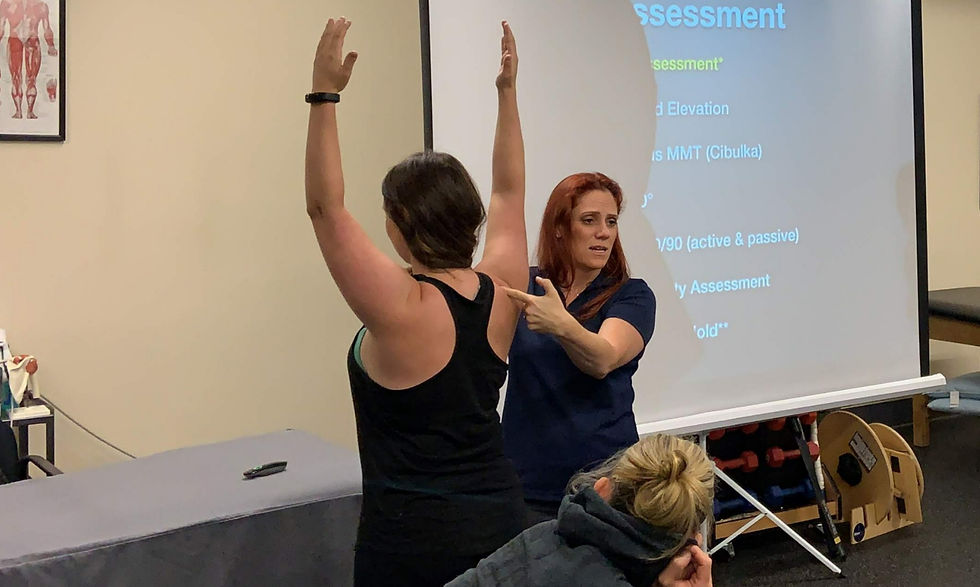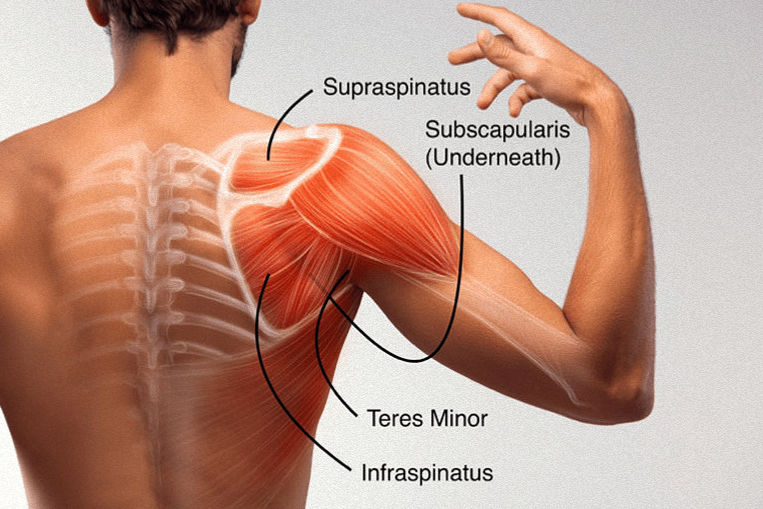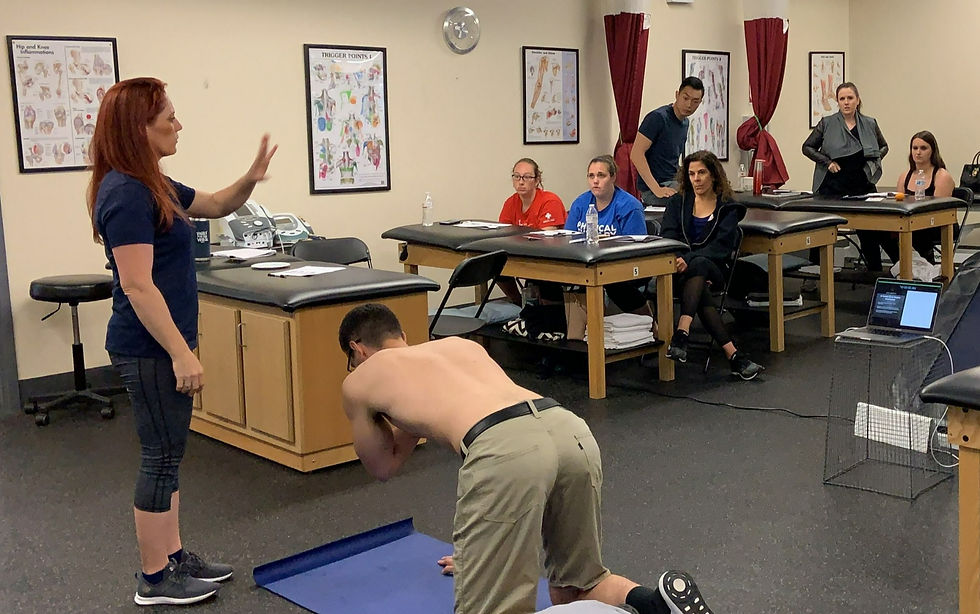Top External Rotation Exercises for Shoulder Health
- Professional Seminars

- Aug 13
- 4 min read
Maintaining optimal shoulder health is essential for clinicians and physical therapists aiming to provide the best care for their patients. Shoulder mobility exercises play a crucial role in preventing injury, improving function, and enhancing rehabilitation outcomes. Among these, external rotation exercises are particularly important for strengthening the rotator cuff and stabilizing the shoulder joint. This article explores the best external rotation exercises, their benefits, and practical recommendations for clinical application.
Importance of Shoulder Mobility Exercises in Clinical Practice
Shoulder mobility exercises are foundational in restoring and maintaining the functional range of motion necessary for daily activities and athletic performance. Limited shoulder mobility can lead to compensatory movement patterns, pain, and increased risk of injury. For healthcare professionals, understanding and implementing effective shoulder mobility exercises is vital for:
Preventing shoulder impingement and rotator cuff injuries
Enhancing post-surgical rehabilitation protocols
Improving patient outcomes in chronic shoulder conditions
Supporting athletes and active individuals in performance optimization
Incorporating targeted mobility exercises into treatment plans can accelerate recovery and reduce the likelihood of recurrent shoulder problems.

Effective Shoulder Mobility Exercises for Rehabilitation and Prevention
A comprehensive shoulder mobility program should include exercises that promote flexibility, strength, and neuromuscular control. Below are some of the most effective shoulder mobility exercises that clinicians can integrate into their practice:
1. Pendulum Swings
Purpose: Gently mobilizes the shoulder joint without active muscle contraction.
Execution: Patient leans forward, allowing the arm to hang freely, then performs small circular or side-to-side movements.
Clinical Tip: Use this early in rehabilitation to reduce stiffness and promote synovial fluid circulation.
2. Wall Slides
Purpose: Enhances scapulothoracic mobility and shoulder flexion.
Execution: Patient stands facing a wall, places forearms on the wall, and slides arms upward while maintaining contact.
Clinical Tip: Encourage scapular upward rotation and posterior tilt during the movement.
3. Sleeper Stretch
Purpose: Improves internal rotation but also indirectly supports external rotation by balancing shoulder musculature.
Execution: Patient lies on the side with the affected shoulder down, gently pushing the forearm toward the table.
Clinical Tip: Hold the stretch for 30 seconds and repeat 3 times daily.
4. Cross-Body Stretch
Purpose: Targets posterior shoulder capsule tightness.
Execution: Patient pulls the arm across the chest with the opposite hand.
Clinical Tip: Avoid excessive force to prevent discomfort.
These exercises form the foundation of shoulder mobility and prepare the joint for strengthening activities, including external rotation exercises.

What muscles does external rotation work?
Understanding the muscular anatomy involved in external rotation is essential for effective exercise prescription. External rotation primarily targets the rotator cuff muscles, which are critical for shoulder stability and function.
Infraspinatus: The main external rotator of the shoulder, responsible for rotating the humerus laterally.
Teres Minor: Assists the infraspinatus in external rotation and stabilizes the humeral head.
Posterior Deltoid: Contributes to external rotation and shoulder extension.
Supraspinatus: Although primarily involved in abduction, it supports rotator cuff function.
Strengthening these muscles through targeted exercises helps maintain the glenohumeral joint's integrity and prevents common pathologies such as impingement and rotator cuff tears.

Top External Rotation Exercises for Clinical Application
Incorporating external rotation exercises into rehabilitation and prevention programs can significantly improve shoulder function. Below are some of the most effective exercises with detailed instructions:
1. Side-Lying External Rotation
Setup: Patient lies on the non-affected side with the elbow bent at 90 degrees, resting against the torso.
Execution: Holding a light dumbbell or resistance band, the patient rotates the forearm upward, keeping the elbow fixed.
Repetitions: 3 sets of 10-15 reps.
Clinical Tip: Emphasize slow, controlled movements to maximize muscle activation.
2. Standing External Rotation with Resistance Band
Setup: Attach a resistance band to a stable anchor at waist height.
Execution: Patient stands sideways to the anchor, holding the band with the hand farthest from the anchor. Keeping the elbow at 90 degrees and close to the body, the patient rotates the arm outward.
Repetitions: 3 sets of 12-15 reps.
Clinical Tip: Adjust band tension to match patient strength and progress gradually.
3. Prone External Rotation
Setup: Patient lies prone on a table with the arm hanging off the side, elbow bent at 90 degrees.
Execution: Patient externally rotates the shoulder by lifting the hand toward the ceiling.
Repetitions: 3 sets of 10-12 reps.
Clinical Tip: This position reduces compensatory movements and isolates the rotator cuff.
4. Cable External Rotation
Setup: Using a cable machine with the handle at waist height.
Execution: Patient stands with the elbow bent at 90 degrees, rotating the arm outward against the cable resistance.
Repetitions: 3 sets of 10-15 reps.
Clinical Tip: Ensure proper posture and scapular stabilization during the exercise.
These exercises can be tailored to individual patient needs and integrated into various stages of rehabilitation or conditioning programs.
Practical Recommendations for Implementing External Rotation Exercises
To maximize the benefits of external rotation exercises, clinicians should consider the following guidelines:
Assessment First: Evaluate shoulder range of motion, strength, and pain levels before prescribing exercises.
Progressive Loading: Start with low resistance and gradually increase as tolerated.
Focus on Form: Proper technique is critical to avoid compensations and ensure targeted muscle activation.
Incorporate Scapular Stabilization: Combine external rotation with exercises that promote scapular control.
Monitor Patient Response: Adjust exercises based on pain, fatigue, and functional improvements.
Educate Patients: Provide clear instructions and rationale to encourage adherence.
Integrating these principles will enhance clinical outcomes and support long-term shoulder health.
For healthcare professionals seeking to deepen their expertise in shoulder rehabilitation, Professional Seminars Ltd. offers specialized courses. These programs are available in-person, hybrid, and online formats to accommodate diverse learning preferences.
Explore more resources including podcasts, blogs, and the "Technique Peek Series" videos to stay updated on the latest clinical practices.












Comments